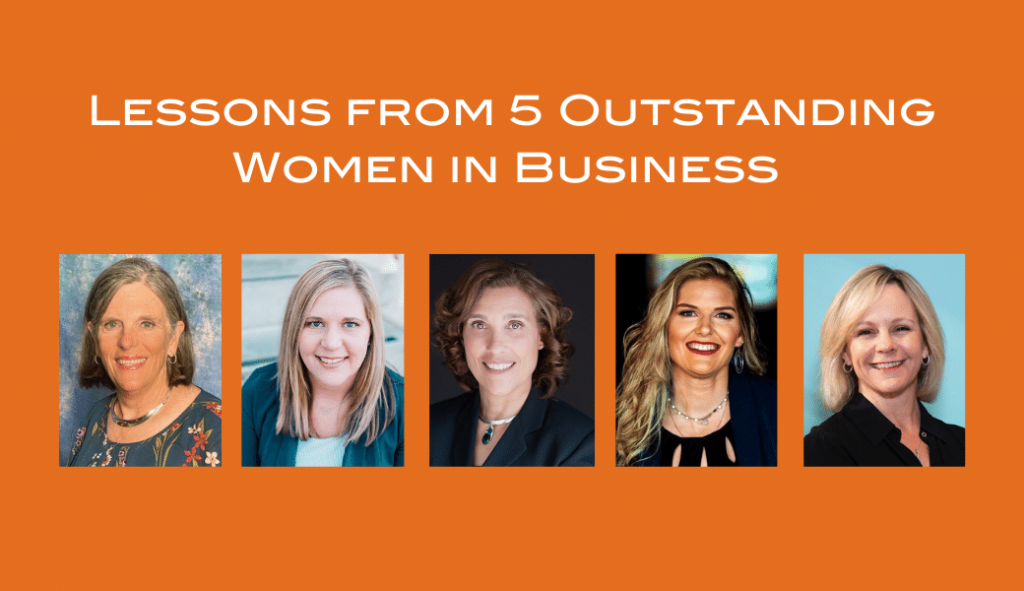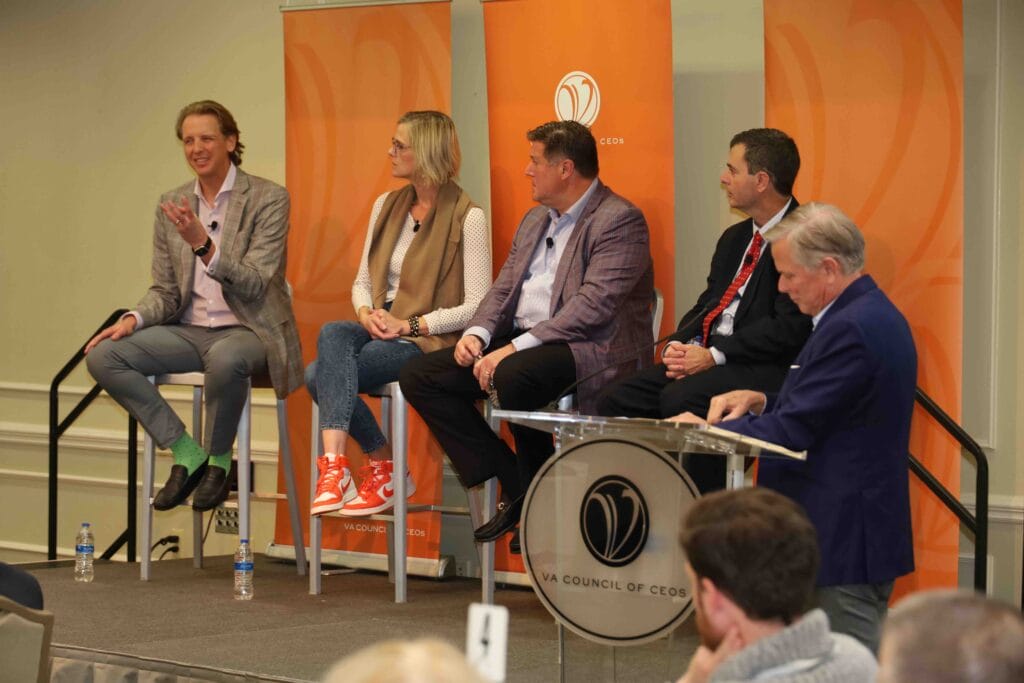Meet Your VACEOs Board of Directors, Part 2
Name: Corey Divine
Company: The Candidate Source
Position on Board: Immediate Past Chair
Something you’ve learned as a member: Every day as a CEO is an adventure. My roundtable, and the greater VACEOs community, are a great resource. By hearing each other’s experiences, we can better navigate the situations we encounter.
Dreams for the future of VACEOs: Since its founding, VACEOs has changed lives. My dream is that we can work together to evolve the organization and serve the CEO of tomorrow. This evolution will allow us to continue changing lives for years to come.
Something more personal: I am married to my beautiful wife Jess. We have a fur-baby named Leo who is a 6-year old beagle that we adopted during COVID. In addition to spending time with family & friends, I spend my free time golfing, cooking, & dabbling in the stock market.
Name: Arlene Lee
Company: Lee Construction Group
Position on Board: 2023 Chair for VACEOs
Something you’ve learned as a member: One thing I learned as a member of VACEOs is the power of shifting from giving advice to sharing experiences. When you give advice, there is often an expectation by the giver that the receiver should follow it. There may be judgement when advice is not followed or resentment if the advice was detrimental. The receiver often feels minimized. However, when you share your experiences, you empower the receiver to make their own decisions and to own the results of those decisions. The result is building people up. As I brought this concept into my business, it was powerful to see the results with my teams feeling more confident not just in making decisions but in making better decisions.
Dreams for the future of VACEOs: In a world where there is so much division and chaos, I am grateful for the safe haven that the Council provides. The conversations there have ripples throughout our companies, communities, and greater world. As VACEOs expands so does the opportunity for healthy conversations. The ideas and best practices that come out of theses conversations will have an impact far greater than we can imagine. In short, my hope for the future of VACEOs is that we grow in footprint and meaning and support for CEOs. And, whether intentional or unintentional, we change the conversation in the greater world in a healthy, collaborative way.
Something more personal: As it turns out, I never outgrew the eight-year-old horse-crazy version of myself. If there is a horse involved, count me in. Currently, I breed Morgan Horses, ride dressage, and drive horses but I have done many other disciples over my lifetime including playing Polo for Cornell. I also enjoy drawing and painting (mostly horses). Outside of that, I am an avid knitter and have 6 books published on knitting designs.
Meet more directors in Part 1
Meet Your VACEOs 2023 Board of Directors, Part 1
Name: B. Scott Crawford
Company: Virginia 811
Position on Board: Director
Something you’ve learned as a member: Honestly, there has been so much I have learned through Roundtable meetings, VACEO workshops, and VACEO conferences it is hard to identify one thing! To name a few; I have learned new perspectives on a host of leadership topics, some interesting insights about changing dynamics in the workforce; and, through our Roundtable Retreat, an interesting perspective on mediocrity and the need to constantly challenge all team members to help them grow – that, in short, “A Players” are not what we really want as those individuals, if performing at the “top of their game” are not necessarily finding room for growth or new challenges. This can lead to burnout and even complacency. A players need to be moved into positions where they are C players in order to provide them with new challenges and room for additional, and continuous, growth. However, the overarching thing I have learned is just how truly important it is to be involved in a group like VACEO where I find opportunities to continue to learn and to be able to safely, in a confidential environment, discuss successes and concerns that I might not be able to discuss in other areas of my life.
Dreams for the future of VACEOs: Identifying ways to grow membership in SW Virginia and building on strategies to increase opportunities for learning and engagement within VACEO.
Something more personal: In my spare time, I enjoy pursuing my passion for history and art history through reading, research, and writing. I have also become an avid runner over the past 6 years (started late in life), and enjoy running with my daughter who runs cross country and track for Radford University.
Name: Chris Leone
Company: WebStrategies, Inc.
Position on Board: Board Member
Something you’ve learned as a member: I’ve learned that there’s nothing unique about the challenges I experience on a daily basis. Every CEO has similar struggles running their business and they’re happy to share them with someone who can relate. At the end of the day, we are just folks who like to build things, take care of our people, and enjoy the “sport” of business.
Dreams for the future of VACEOs: I’d like to see VACEOs become a safe haven and supportive community for the next generation of CEOs and entrepreneurs in Virginia.
Something more personal: The leader of a growing company is forced to evolve several times to keep pace with the needs of the business. This provides a wonderful opportunity to continue growing my skill sets. I’ve also gained a new-found respect for self-care so I can be the best version of myself for my team. I’ve discovered a love for cycling, I carve out more time with my kids, and I give myself permission to “switch off.” Several years ago, I would feel guilty for not always working. Today, I’ve found a better balance that makes me a better leader, husband, and father.
Meet more directors in Part 2
Top 10 Blog Posts of 2022
Each month we work hard to bring you content of interest to you and news you can use. From tactical takeaways to strategic planning to CEO profiles that intrigue, here are the most-read stories of the year.
What kind of content would you like to see posted to vaceos.org? More CEOs profiles? More business tips? Is there a specific topic you would like covered? Please, let us know!
10. Attracting & Retaining Top Talent During the Great Resignation
Take a look at the results from our state-wide survey looking at hiring and workplace challenges. Spoiler warning: they were positive!
9. Q&A with Lauren Sweeney, CEO of Dotted Line
Dotted Line’s CEO Lauren Sweeney tells us about her journey and experiences in her entrepreneurship.
8. 3 Ways to Tackle Inflation Challenges
Inflation is an always present issue in our economy, businesses, and personal lives. Take a look at 3 ways to combat this issue as a CEO.
Is one of your New Year’s resolutions to be more productive? In this post, we’ve included several tools and tips to make that come true.
Get to know our Chairman of the Board, Corey Divine, in this Q&A!
5. What Our Members Are Reading to Be Better Leaders
Need some book recommendations? Want to expand your knowledge as a CEO with advice from the very best? Find some reads here!
4. Leadership Lessons from 5 Outstanding Women in Business

Valuing diversity is one of VACEOs core values, and we appreciate and recognize some outstanding women CEOs in this post.
3. Spring Retreat 2022: Keynote Speakers Announced
We were excited to announce our speakers for this year’s Spring Retreat and our readers were excited to find out! Thank you again to our speakers.
2. 5 Questions Every CEO Should Ask Their Banker
A banker shares what to ask your banker to improve your business’s financial profile. Have you found the answers yet?
MOST POPULAR READ OF 2022:
Making the World a Better Place, One Job Seeker at a Time

Our most read blog post of the year was our Member Spotlight on Glenn Diersen of Summit Human Capital. Get to know him more if you haven’t already!
Use a Balanced Scorecard to Measure Business Performance
“There were 5 exabytes of information created between the dawn of civilization through 2003, but that much information is now created every two days.”
Eric Schmidt, Executive Chairman at Google
A Game Changed
The future’s history books — which I’m guessing will only exist in some digital format — will undoubtedly chronicle the past 50 years as a nearly incomprehensible explosion in human knowledge.
The period from the late 1970s to now has been referred to by many names: The Computing Age, The Dawn of New Media, The Digital Age. No matter the name, modern society has crowned information as its king and as a result, the new battlefront for modern business is data and analytics.
No matter the industry, the consequence of losing the data war with competitors is incomplete (and/or bad and/or nonexistent) information informing critical decisions by executive leadership. Making matters worse, the new landscape has rendered many traditional organizational measures obsolete. In response, new tools and weapons for this new data war had to be forged.
Finding Balance in the Data Onslaught
In 1992, two esteemed professors at Harvard, Robert Kaplan and David Norton, saw the new paradigm and went to work developing just such a tool. It was called the balanced scorecard.
Time and perspective have shown the now-obvious shortfalls of measuring an organization in strictly financial terms. Even a century ago, the operations and strategies of most large American companies were far too dynamic to accurately assess with the same handful of pecuniary benchmarks.
Fast forward to now and the complexities of the modern age and it’s genuinely silly to think any single measure (or a handful of measures) could give a comprehensive picture of the overall health of an organization. We need balance. We need a more dynamic assessment of performance vs. objectives. We must consider the financial and the non-financial. We can achieve this through the scorecard.
Take Key Performance Indicators Beyond Finance
It’s noteworthy here to mention that entire college courses are devoted to the minutia of building Kaplan and Norton’s balanced scorecard. Lucky for us, it remains a relatively easy concept to explain at a high level. In a nutshell, it’s a simple framework in four easy parts: Financial, Customer, Internal, and Growth. For each, the task is simple: find the key performance indicators.
While there is no shortage of financial measures to use as KPIs, the other three areas might require a deeper dive.
Struggling to measure overall customer satisfaction? Take a look at what percentage of your widgets get returned. Trying to assess internal efficiency? One might look at the length of lead time between product design and going to market. Unsure about your company’s capacity to innovate? The examples are bountiful and the results are almost always transformative. One of my favorite clients of all time used to live by one mantra: a process examined is a process improved.
To this, I might also add that a process, upon examination, usually reveals how poorly company metrics accurately capture the success or failure of specific strategies. I liken it to focusing on a restaurant’s food servers to evaluate the efficiency of the cooks.
Proven Effectiveness
Now, speaking conceptually about the scorecard provides a great overview, but nothing better demonstrates its effectiveness than its real-world assimilation into the world’s biggest company, Apple.
For context, Apple had traditionally focused almost exclusively on its technologies building computers. Executive leadership was product-focused, and their measures of choice were the same contemporary gauges used by most other large global enterprises (ROI, gross margin, market share, etc).
The task of procuring feedback from outside the company had usually fallen on third parties like JD Power. Apple knew the limits of depending on someone else for such critical input and executives had come to realize that then-current measures were not capable of articulating the effectiveness of critical strategies. Leadership’s response was to adopt Kaplan and Norton’s balanced scorecard.
All four elements (Financial, Customer, Internal, and Growth) were considered by Apple executives. Going forward, financial measures would emphasize shareholder value; from the internal process perspective, core competencies; the Growth perspective, employee attitudes. And perhaps the most important change was an emphasis on the customer perspective through market share and customer satisfaction.
Apple no longer outsourced customer feedback. They developed specific surveys that sought to inform their future. From them, the computer builder realized their loyal but disparate customers were looking for similar things; user-friendly interfaces, more powerful software architectures, and better distribution systems — things that define what we now think of when we think about Apple.
Link Measures to Activities in a Dashboard
Finally, once an organization has undertaken the leadership responsibilities and heavy lifting of building its individualized scorecard, it would be short-sighted not to link those results and KPIs to a dynamic, powerful, and highly effective dashboard.
In my experience, dashboards are one of the best tools for first linking measures to activities, then activities to objectives, and finally objectives to performance. ZOHO is my favorite. It’s the best dashboard value out there. (And no, I’m not a paid spokesperson nor do I benefit in any way from this endorsement).
About the Author
Russ Gambrel, a finance & accounting consultant for Fahrenheit Advisors, is a CPA with more than 22 distinguished years of accounting, auditing, and information systems experience. He has spent the last ten years working with a who’s-who list of Virginia-based start-ups and large companies consulting extensively as both a fractional CFO and Controller. Prior to moving to Virginia, Russ tracked countless miles from his start in Silicon Valley to Washington, D.C., leading both small and large companies in their Sarbanes-Oxley compliance efforts. Before joining the private sector, Russ worked and lived in the European theater as a Budget Director with the DOD. Additionally, he is a former University accounting and finance instructor whose Master’s studies in Information Systems focused on relational database design.

CEOs see Opportunity in Downturn

Inflation. Slowing demand. Rising interest rates. Everyone is talking about a recession. Whether a recession happens or not, most CEOs are anxious about what the future holds for their businesses. This was the topic for ninety business owners at a recent VA Council of CEOs luncheon.
When these CEOs were asked, “Is a potential recession more of a threat or an opportunity for your business?”, almost two-thirds of them saw more opportunity. The Lewis Group’s John Lewis predicted that the stock market will turn around and go “to new highs,” citing the economy’s fundamental strength and historical trends. Many of these entrepreneurs said they felt more prepared this time, having survived the Great Recession. Three themes emerged from the discussion.
Survival of the Fittest
A number of CEOs said that it was time to “flush the system,” leaving flexible, well-prepared organizations with the advantage and effectively weeding out the competition. The fittest will have the opportunity to acquire talent, assets, and market share from weaker competitors. Some talked about the creativity that businesses experience when faced with challenging times. Others shared that now was an important time to focus on your organization’s mission and vision — and to communicate optimism for the future to employees and customers.
Cooling Talent Market
Could a downturn bring an end to the workforce crisis? Many of the CEOs said they expect the challenges in recruiting and retaining talent to ease. Those firms that focus on providing attractive work environments and growth opportunities for their people will have an advantage. Susie Fife of Red Orange Studios said she works hard to “make sure that [her] employees know that they are supported.”
New Growth
Several luncheon participants excitedly noted the opportunity for growth. Henry Clifford of Livewire said that some new services they created out of internal necessity “have proven successful and turned into industry-facing efforts.” Many of the CEOs said they looked forward to leveraging partnerships that might not have been possible in the past. And organizations with deeper pockets and the right talent in place are positioned to acquire other businesses and take market share.
Doug Moore with Fahrenheit Advisors started the luncheon conversation by quoting Andy Grove’s book title: “Only the Paranoid Survive.” The audience of CEOs, entrepreneurs, and business owners agreed. However, most in this audience were more focused on the opportunities to be found in disruption.
Do you see more threat or opportunity in the potential recession? Share your thoughts in the comments!







Recent Comments